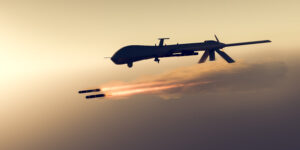Iran: A Dangerous Game
The downing of a sophisticated U.S. RQ-170 Sentinel drone over Iran is the latest ratcheting of tension among Washington, Tehran and Jerusalem.
The downing of a sophisticated U.S. RQ-170 Sentinel drone over Iran is the latest ratcheting of tension among Washington, Tehran and Jerusalem. Iran’s nuclear enrichment facilities have been crippled by sophisticated cyber attacks. Key Iranian scientists and officials have been killed, including a senior Iranian Revolutionary Guard commander who died when a rocket research site was hit by a spectacular and still unexplained explosion.
That we know. But what else is going on in this murky, dangerous game?
In July 2008, Seymour Hersh reported in The New Yorker that in the previous year the U.S. Congress agreed to a request from President George W. Bush “to fund a major escalation of covert operations against Iran, according to current and former military, intelligence and congressional sources. These operations, for which the president sought up to $400 million, were described in a Presidential Finding signed by Bush, and are designed to destabilize the country’s religious leadership. The covert activities involve support of the minority Ahwazi Arab and Baluchi groups and other dissident organizations. They also include gathering intelligence about Iran’s suspected nuclear-weapons program.”
That American backing included support for actions, which, were they to be committed against the United States or one of its allies, would definitely qualify as “terrorism.”
Has the support for such operations continued under President Obama? If so, what does it include? Just financial backing? Training? Logistics? Clandestine raids into Iran? American “boots on the ground”?
Predictably, such aggressive acts will provoke retaliation from Iran — a situation that in the context of America’s superheated presidential primaries could spiral dangerously out of control. Which is just what militants in Tehran, Jerusalem and Washington may be out to provoke.
We know from President George H.W. Bush’s decision to fund the opposition to Saddam Hussein in 1991 that once such a program is launched it takes on a life of its own — extremely tricky to control, even more difficult to shut down by succeeding presidents, as Bill Clinton would discover. The funding created its own lobby, ready to run to the media and sympathetic congressman at any attempt to rein it in.
Such a potentially explosive situation would be nothing new. Washington has already been involved in a much more violent clandestine war against Iran, via its de facto ally of the time, Saddam Hussein, who invaded Iran in 1980.
From early in the conflict, the U.S. secretly supplied Saddam with arms as well as satellite intelligence. By 1987, Washington was shipping American-made weapons directly to Iraq from the sprawling U.S. Rhein-Main Air Base in Frankfurt, Germany. Some of Saddam’s elite troops were even being sent to the United States for instruction in unconventional warfare by U.S. Special Forces at Fort Bragg.
As I detail in my book, Web of Deceit, the Reagan administration would be dangerously sucked even deeper into the conflict. Encouraged by the U.S., Saddam intensified his attacks against vital Iranian economic targets, including neutral tankers in the Gulf. Iran, of course, retaliated. Concerned about the safety of their own ships, the Kuwaitis asked for protection.
Some U.S. officials worried back then — just as they do today — that by venturing into the narrow confines of the Gulf, the U.S. risked direct conflict with Iran. Despite such concerns, American warships were dispatched.
In May 1987, it became dramatically clear how dangerous that policy was. An Iraqi Air Force plane mistakenly attacked an American frigate, the U.S.S. Stark, killing 37 of the crew.
Then, to counter mounting congressional opposition to the operation, the Reagan administration decided to go one step further. It would justify a continued U.S. presence in the Gulf by permitting Kuwaiti ships to operate under the American flag.
That fiction would give the Kuwaitis the right to American protection.
A U.S. liaison officer was stationed in Baghdad to avoid a repeat of the Stark incident.
That, at least, was the cover story; in fact, over the following months, American officers would help Iraq carry out long-range strikes against key Iranian targets, using U.S. ships as navigational aids. “We became,” as one senior U.S. officer told ABC’s Nightline, “forward air controllers for the Iraqi Air Force.”
The Reagan administration, in effect, decided to undertake a secret war, not bothering with congressional authorization.
Heavily armed U.S. Special Operations helicopters, stealthy, sophisticated killing machines that could operate by day or night, were ordered to the Persian Gulf. Their mission was to destroy any Iranian gunboats they could find. Other small, swift American vessels, posing as commercial ships, lured Iranian naval vessels into international waters to attack them. The Americans often claimed they attacked the Iranian ships only after the Iranians first menaced neutral ships plying the Gulf. In some cases however, the neutral ships that the Americans claimed to be defending didn’t even exist.
Beginning in July 1987, the CIA also began sending covert spy planes and helicopters over Iranian bases. Several engaged in secret bombing runs, at one point destroying an Iranian warehouse full of mines. In September 1987, a special operations helicopter team attacked an Iranian mine-laying ship with a hail of rockets and machine-gun fire, killing three Iranian sailors. Official authorization for those clandestine attacks was purposely restricted to a low level in the Reagan administration so that top government officials could deny all knowledge of the illegal operations.
By early 1988, officers from the Pentagon’s Defense Intelligence Agency dispatched to Baghdad were actually planning day-by-day strategic bombing strikes for the Iraqi Air Force. In April 1988, the day before a key Iraqi offensive, U.S. forces sank or demolished half the Iranian navy — one destroyer and a couple of frigates.
If Saddam had not ultimately prevailed, the Pentagon had prepared an even more ambitious strategy: to launch an attack against the Iranian mainland. “The real plans were for a secret war, with the U.S. on the side of Iraq against Iran, on a daily basis,” retired Lt. Col. Roger Charles, who was serving in the office of the secretary of defense at the time, told British reporter Alan Friedman.
As Adm. James A. “Ace” Lyons, who was commander in chief of the U.S. Pacific Fleet put it, “We were prepared, I would say at the time, to drill them back to the fourth century.”
Relatively cooler heads prevailed. According to Richard L. Armitage, who at the time was assistant secretary of defense, “The decision was made not to completely obliterate Iran. We didn’t want a naked Iran. We wanted a calm, quiet peaceful Iran. However, had things not gone well in the Gulf, I’ve no doubt that we would have put those plans into effect.”
Which brings us back to today.
Barry M. Lando spent 25 years as an award-winning investigative producer with “60 Minutes.” He has produced numerous articles, a documentary and a book, “Web of Deceit,” about Iraq. Lando is just finishing a novel, “The Watchman’s File.”
Your support matters…Independent journalism is under threat and overshadowed by heavily funded mainstream media.
You can help level the playing field. Become a member.
Your tax-deductible contribution keeps us digging beneath the headlines to give you thought-provoking, investigative reporting and analysis that unearths what's really happening- without compromise.
Give today to support our courageous, independent journalists.






You need to be a supporter to comment.
There are currently no responses to this article.
Be the first to respond.